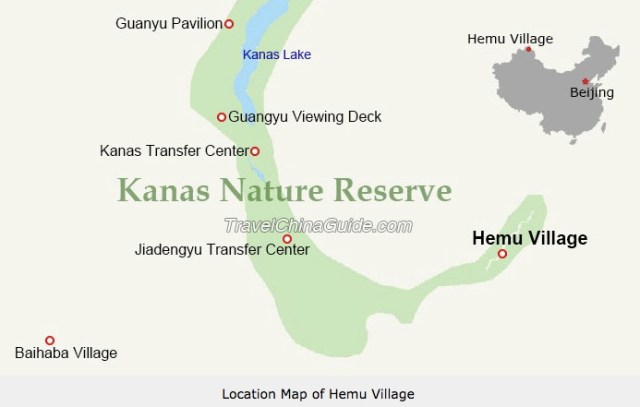
 Courtesy of PeachBlossomGoddess, who provided these infos in a reply, here's the short answer:it was filmed in Altay, Xinjiang, Hemu Village, Burqin County and other places. (I am adding some pictures from various pages, such as Kanas lake, above)
Courtesy of PeachBlossomGoddess, who provided these infos in a reply, here's the short answer:it was filmed in Altay, Xinjiang, Hemu Village, Burqin County and other places. (I am adding some pictures from various pages, such as Kanas lake, above)
To which this document was added : http://www.mnw.cn/tv/guonei/2719857.html Translation below :
"This drama "is an urban emotional drama directed by Yu Cuihua and starring Jing Boran and Tan Songyun. In the released trailer, you can see that the shooting scenes are very beautiful. I believe everyone should be very curious about where the scenes in the play were shot. Let's find out together!| Where was the TV series Homecoming filmed? The modern drama "The Way Back" was filmed in Altay, Xinjiang, Hemu Village, Burqin County and other places.
"The Way Back" is adapted from Mo Bao Feibao's novel of the same name. It tells the story of a pair of lovers in their school days who reunite after many years. He is a special police officer and she is an urban beauty. Again later, Gui Xiao, the heroine played by Tan Songyun, was separated from the male protagonist due to family reasons when she was a student. Due to her self-esteem, the female protagonist was unwilling to tell others about the unbearable family affairs. The two were separated by thousands of miles, finally broke up.
"The male protagonist Lu Yanchen played by Jing Boran is a tough guy, and after many years of separation, he still had his heart set on the female lead.
"Altay 阿勒泰 -- In the northernmost part of Xinjiang, Altay is a beautiful mountain city with a beautiful environment and a leisurely life. People in Xinjiang are famous for their hospitality, and many people who go to the mainland also like the human relations there. If you really want to go, you can try to stay for a while and try to experience life in Xinjiang.
"Although there are some costs, Altay is full of beautiful scenery in winter. If you go to Altay in winter, you must pay attention to the cold and sun protection. Altay's big-tailed sheep is a tasty meat. The mutton is not fat, and the pit meat is especially delicious. The formation of Jing Boran's character comes from two aspects, one is his family background, and the other is his work and study environment.
"The Altay region belongs to the Xinjiang Uygur Autonomous Region and is under the jurisdiction of the Ili Kazakh Autonomous Prefecture. Located in the northern part of Xinjiang, bordering Russia, Kazakhstan, and Mongolia; the landforms are complex and diverse, with hot and dry summers and severe cold winters; the border is 1,197 kilometers long, with a total area of 118,000 square kilometers. It governs 6 counties and 1 city; according to the seventh census data, as of 0:00 on November 1, 2020, the permanent population of Altay was 668,587.
"The Altay region is the only region bordering Russia in Northwest China. It is an important node city for the northern channel of the Silk Road Economic Belt and Xinjiang’s participation in the construction of the China-Mongolia-Russia Economic Corridor. It has 3 national land ports. It is also a relatively water-rich areai known as the "Water Tower" in northern Xinjiang. Besides, it is one of the six major forest areas in the country, and it is also designated by the State Council as a water conservation-type mountainous grassland ecological function area. It is known as "Golden Mountains and Silver Waters".

"Hemu Village 禾木村 Hemu Village is a village under the jurisdiction of Burqin County, Xinjiang Uygur Autonomous Region. Located on the bank of Kanas Lake in Burqin County, Xinjiang, it is a concentrated living place for Tuva people. It is the farthest and largest village among the only remaining 3 Tuva villages (Hemu Village, Kanas Village and Baihaba Village), with a total area of 3040 square kilometers.The houses in Hemu Village are all made of logs, full of primitive flavor.
"Hemu Village is most famous for its intoxicating autumn colors all over Wanshan. The smoke from cooking houses rises slowly in the autumn colors, forming a dreamlike smoke belt, which is better than a fairyland. On the hillside around Hemu Village, you can overlook the panorama of Hemu Village and Hemu River: ghosts in empty valleys, small bridges and flowing water, horse herders passing through the forest...
"Beside the beautiful Kanas Lake in Xinjiang, there is a small mountain village - Hemu Village, which is known as "the first village in China". Wooden houses built of logs are scattered in the village, with small bridges flowing over water, and smoke curling up from kitchens... The simple and unsophisticated mountain village scenery is as mysterious as Kanas Lake."
----
Some additional info about Hemu Village where the snow scenes in the first episodes were filmed: 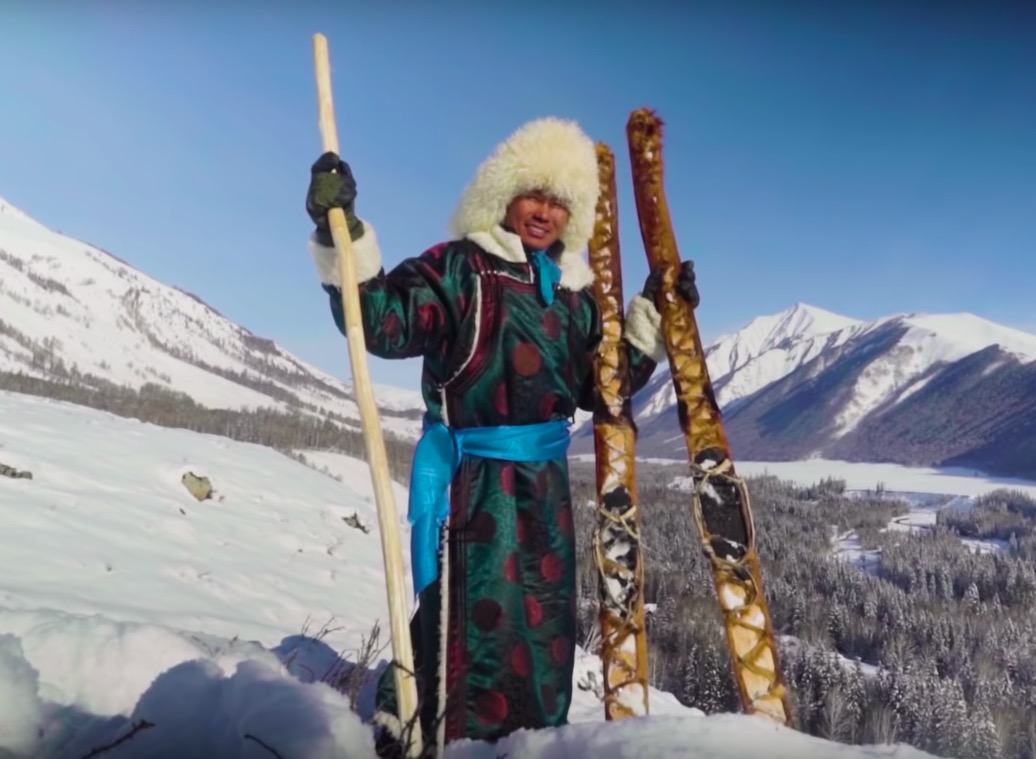
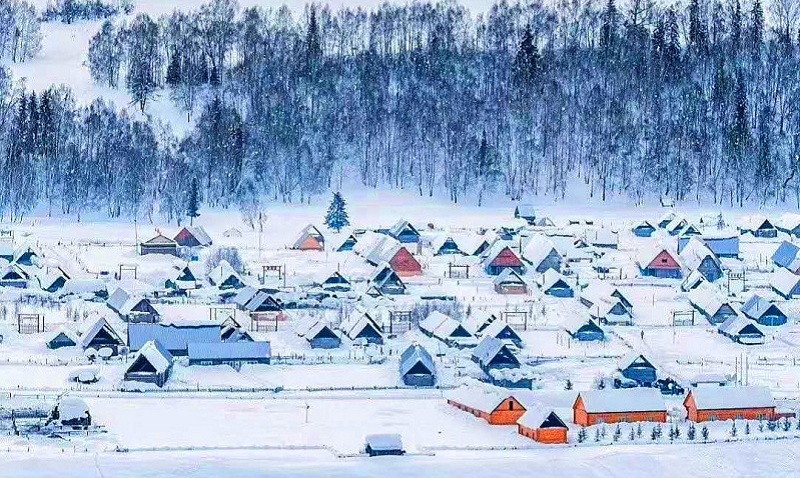
Hemu village in Tuva area of northern Xinjiang has lots of wooden houses, forest around and snow in winter. It is one area which is looking forward to develop winter sports too and has a reputation as "most beautiful village in China". The typical wooden houses with nailed planks are partly dug into the ground because of heavy snow and cold in winters. It is the most remote and largest of the three habitats of the Tuva ethnic group, which are related to the Mongols (the Tuvas claim to be descended from Genghis Khan warriors),
Tuvans who belong to a Turkic ethnic group with their own culture, language and dialects, live both in Russia, in Mongolia, and in China, where they mostly can be found around Lake Kanas They are included as ethnic minority Mongols, "part of the local Oirat Mongol community" generally labeled as "Mongol". Oirat and Tuvan children attend schools in which they use Chakhar Mongolian and Mandarin Chinese. "
Interestingly, among their customs, "Tuvan people have been skiing for thousands of years, primarily for the purpose of hunting elk. Tuvan hunters would track an elk in a heavy snow region and once they spotted an elk, they would ski downhill fast and throw a lasso to catch their game. Although the origin of skiiing is hotly debated, some experts believe that the Tuvan people in the Altay mountains may have been the earliest humans to master skiing for the purpose of hunting, due to ancient cave paintings in the region depicting ancient skiers chasing big game. However nowadays in the same region within Xinjiang, the hunting of animals have been banned by the Chinese government, who had made the entire mountain into a conservation area But the Tuvan people still actively and legally engage in "catch-and-release" hunting of elk using their traditional methods. " (Wikipedia)
PeachBlossomGoddess added these documents about skiing around Hemu village:
https://www.china-silkroad-travel.com/our-blog/hemu-ski-resort.html
https://unofficialnetworks.com/2020/02/07/ancient-chinese-ski-village/
The second link includes the map to show where Hemu Village is located, near the Kanas Nature Reserve, and the distance to Beijing. There are flights between Beijing and Altay, and also high speed rail connection.
----
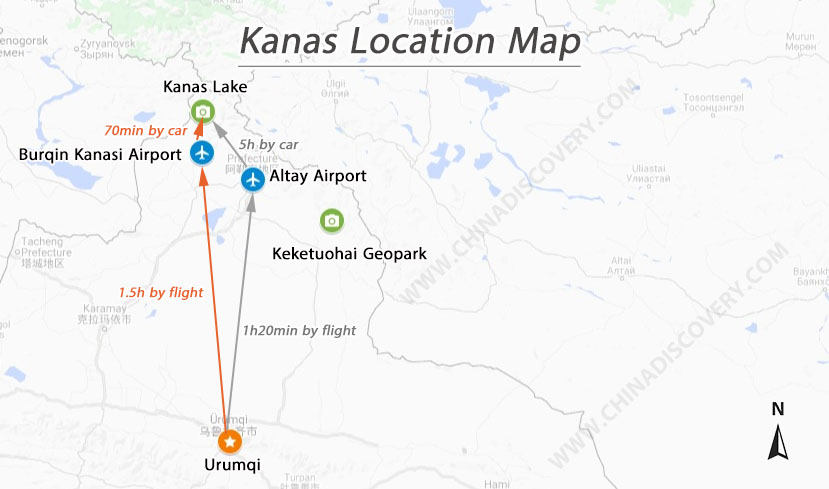
"Hemu Village, is only 70 km away from Kanas Lake. The traditional living style and unparalleled natural landscape make Hemu a perfect retreat away from the world. Therefore, Hemu is usually traveled with Kanas. After you get to Kanas and finish the visit, you can keep driving for about 1.5 hours to get to Hemu and spend a couple of days there. If you want to get to Hemu directly, you can charter a car in Burqin (175km, nearly 4 hours’ drive from Hemu) or Altay (290km, 5.5 hours’ drive from Hemu).
Burqin Kanasi Airport sometimes runs tourist buses to Hemu in the peak season or when there are many tourists. Zhengzhou Xinzheng International Airport operates one stopover flight to Burqin Kanasi Airport on Saturday. But Altay Airport is connected with more cities than Burqin Kanasi Airport does. You can get to Altay from Korla (1h20min), Kashgar (4h), Urumqi (1h20min), Yining (1h20min), Karamay (1h15min), Tacheng (1h), Xian (4h), Chongqing (6.5h), etc.
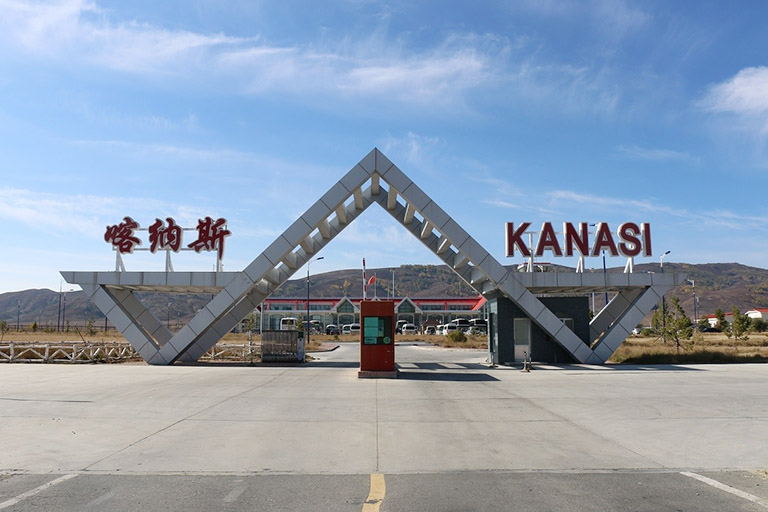
 Burqin Kanasi and Altay airports
Burqin Kanasi and Altay airports
----
 In the novel there was a reference to "a certain gas station in the Inner Mongolia Autonomous Region." Further in the book, I spotted the name Erenhot. Erenhot is "a county-level city of the Xilin Gol League, in Inner Mongolia Autonomous Region, located in the Gobi Desert along the Sino-Mongolian border, across from the Mongolian town of Zamyn-Üüd. There are 74,197 inhabitants". Its livelihood is derived from foreign trade traffic, since Erenhot sits on the Transmongolian railway since 1954 : it is "the only railway border entrance between the two countries, and it provides a shorter line connecting Beijing with Moscow than the one through Northeast China (Manchuria). " (Wikipedia & Britannica).
In the novel there was a reference to "a certain gas station in the Inner Mongolia Autonomous Region." Further in the book, I spotted the name Erenhot. Erenhot is "a county-level city of the Xilin Gol League, in Inner Mongolia Autonomous Region, located in the Gobi Desert along the Sino-Mongolian border, across from the Mongolian town of Zamyn-Üüd. There are 74,197 inhabitants". Its livelihood is derived from foreign trade traffic, since Erenhot sits on the Transmongolian railway since 1954 : it is "the only railway border entrance between the two countries, and it provides a shorter line connecting Beijing with Moscow than the one through Northeast China (Manchuria). " (Wikipedia & Britannica).
The Chinese-Mongolia train track at Erenhot:
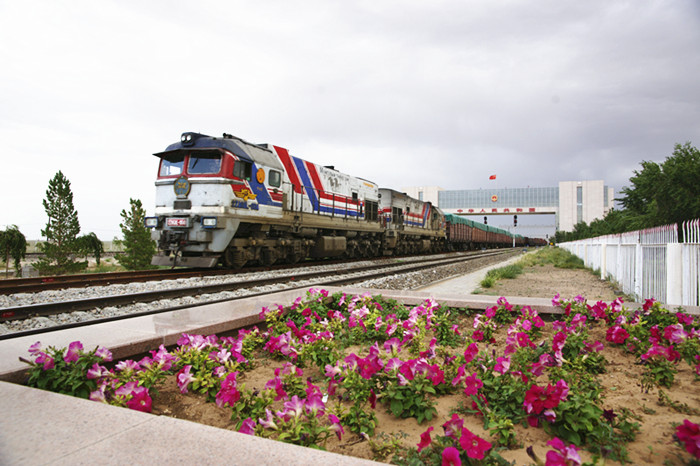
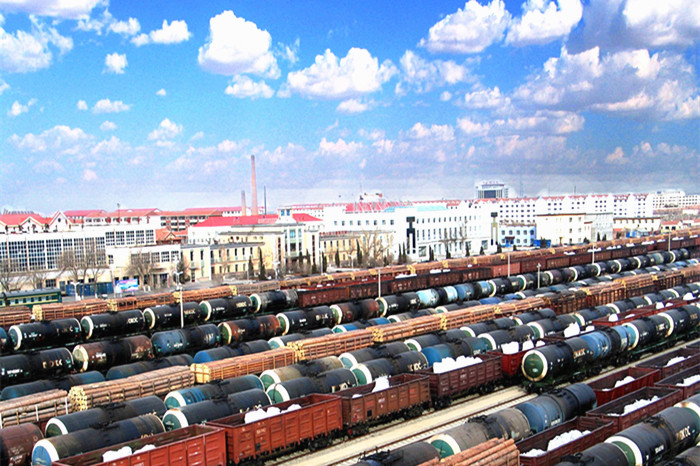
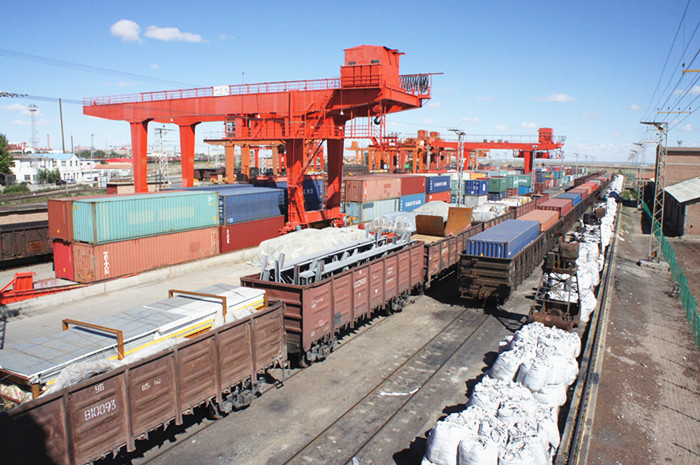 But the drama chose more picturesque places (Hemu Village and Altay city) for the fictitious Qining.
But the drama chose more picturesque places (Hemu Village and Altay city) for the fictitious Qining.
----
Other shooting locales in the first episodes are around Beijing. The 341 hospital seems fictitious, but there is a 301 PLA hospital and medical school all the way west (in Shijingshan district) from the Beijing city center. Beautiful well preserved relatively large siheyuan (courtyard) dwellings like the one Lu Yan Chen's parents inhabit are perhaps not that easy to come by in the remote parts of Beijing outside 5th ring, but there are some like that in Xicheng or Dongcheng district.
***** Anyone who wishes to contribute more are welcome to add info here.
The cross border train connections between countries are not yet in the Altay region but further south, though. To travel cross border Altay traffic first needs to be routed through Urumqi or Kuytun (Kuytun is the largest material transit, distribution and transportation hub in the Northern Xinjiang area, the G30 and G3014 National Expressways, G312 and G217 National Highways meet here. It is a railway junction for the Northern Xinjiang, Second Ürümqi-Jinghe and Kuytun-Beitun Railways; Beitun is linked by rail to Altay). The map below shows train routes as planned (and already constructed by 2015) ; exit point in Xinjiang to Kazakhstan are at Alashankou and new Khorgos (Altynkol in Kz) .
Trains began running on the Beitun-Altay Railway in the Xinjiang Uygur autonomous region in 2017, finally connecting the city to China’s national railway network.
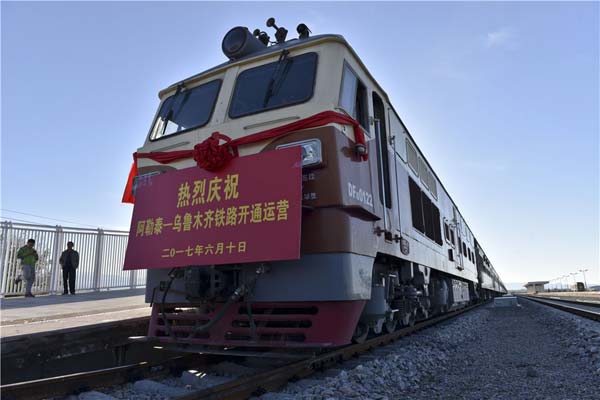
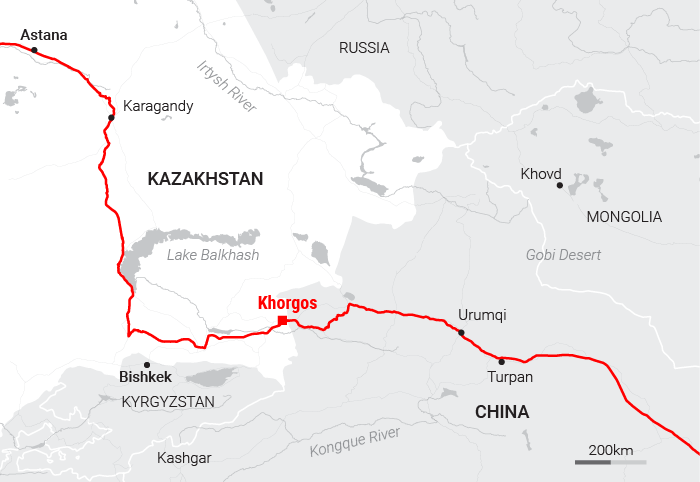
The reorientation of cargo flows from the interstate point of the Dostyk-Alashankou crossing to Altynkol-Khorgos increases the speed processing of trains coming from a standard railway track (1435 mm) to a wide (1520 mm), including customs clearance,
In 2022, the Alashankou and Khorgos stations located on the border with Kazakhstan passed 13.3 thousand freight trains on the China-Europe direction, which is 8.7% more than in 2021. The number of trains departing from the Xinjiang Uygur Autonomous Region , in 2022 increased by 21.5% compared to 2021, amounting to 1440 units.
More info about Khorgos here : https://multimedia.scmp.com/news/china/article/One-Belt-One-Road/khorgos.html
It is mostly block (cargo) trains on the Belt and Road line, but there are also passenger (sleeper) trains between Urumqi in Xinjiang to Almaty in Kazakhstan (33 hrs journey). Because of difference in width, there is a change in train wheel sets at the border. This video gives details about the journey : https://www.youtube.com/watch?v=1gz8W5K9_6A
" Two trains per week link Almaty in Kazakhstan with Ürümqi in China, one using the original route through Druzhba/Alashankou, the other via the new much shorter route through Horgos/Altynkol. One train per week carries through cars Astana-Ürümqi. One set of carriages is Kazak with 2-berth and 4-berth sleepers, the other set Chinese with modern air-conditioned soft class 4-berth sleeper compartments and hard class open-plan bunks. A Kazak restaurant car runs Almaty to the border, and a Chinese restaurant car runs from the border to Ürümqi. - Urumqi SOUTH Railway Station. Window 12 handles international trains." Train K9797 at Ürümqi :
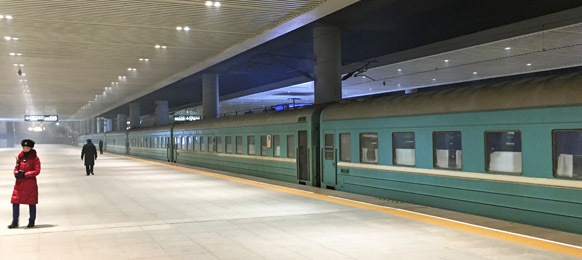


July 5, 2022 - Alashankou Port in Northwest China’s Xinjiang Uygur Autonomous Region has registered an increase in China-Europe rail freight traffic, totaling 3,000 trains in 2022 so far. containers trains at Alashankou port, Bortala Mongol autonomous prefecture, northwest China’s Xinjiang Uygur autonomous region.
Below : passenger train from Xinjiang to Kazakhstan.
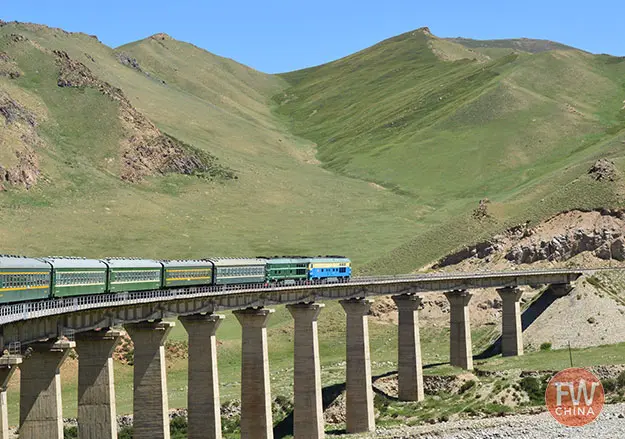
Fascinating article! Better than Tripadvisor! Lol. Thanks a lot for the information related to the shooting location and the extras 🙏🏼🙏🏼🙏🏼 @Frost_edelweiss.
I hope to visit Urumqi when the international and local connecting flights are available. I recalled going to Ulan Bator few years ago was a bit difficult cos there weren't that many flights in and out.
Do visit the Xinjiang and the Silk Road if you can! And the northwest that we see in this drama!
Ulaanbaatar is not in China, it is very different from Hohhot in Inner Mongolia, from which you can easily travel to many interesting places (the city itself also has places worth a visit). I am not sure UB is the most exciting place to be stuck in.
Yeah, it will be fun to travel again not only virtually!
Episode 22-Where did Lu Yanchen and Gui Xiao cross a glass bridge and Qin Mingyu and Duan Rou cross a double plank gap footbridge ? Watch https://www.iq.com/play/road-home-i34y3t1psc?lang=en_us and https://www.iq.com/play/road-home-18fedyl2iac?lang=en_us
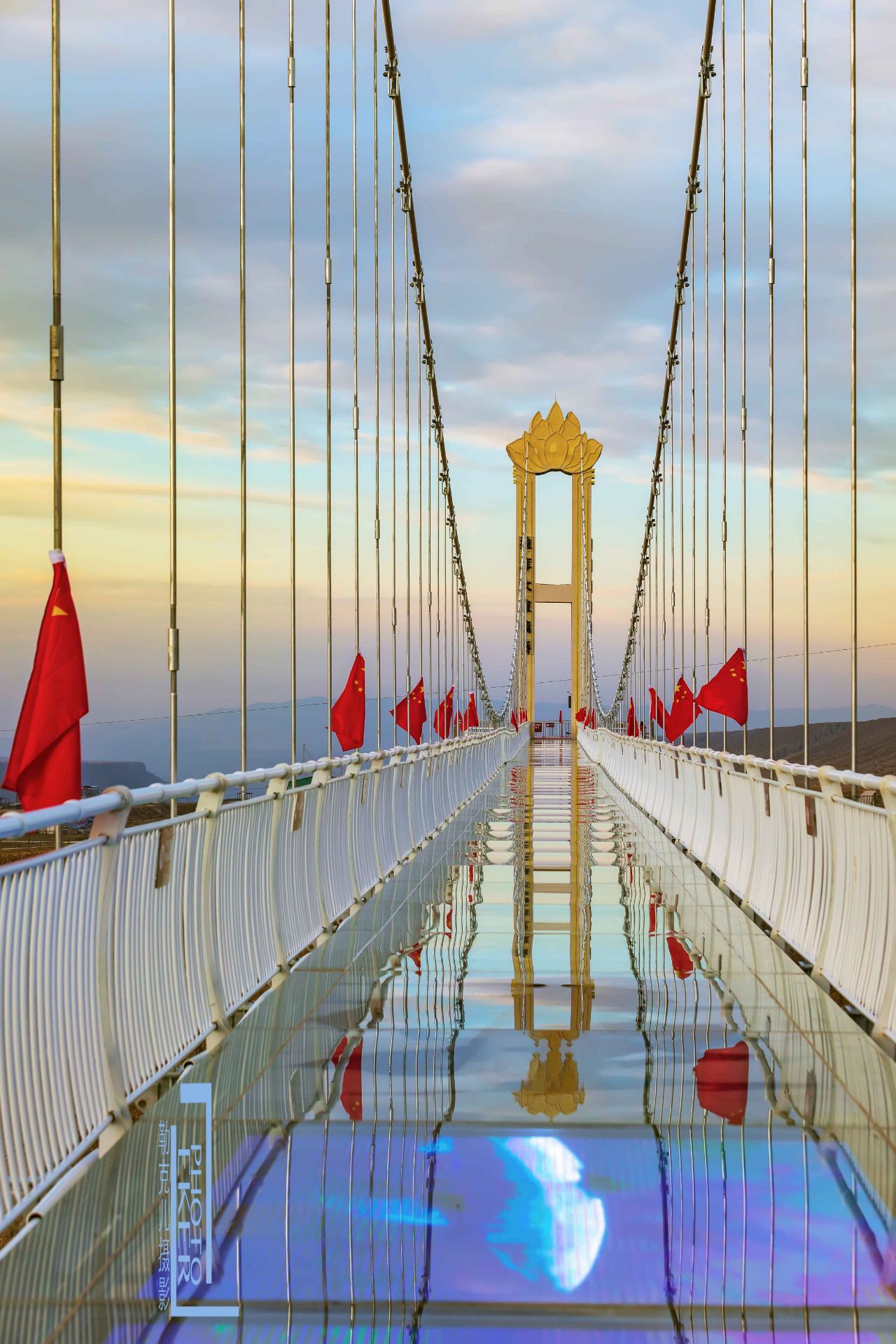
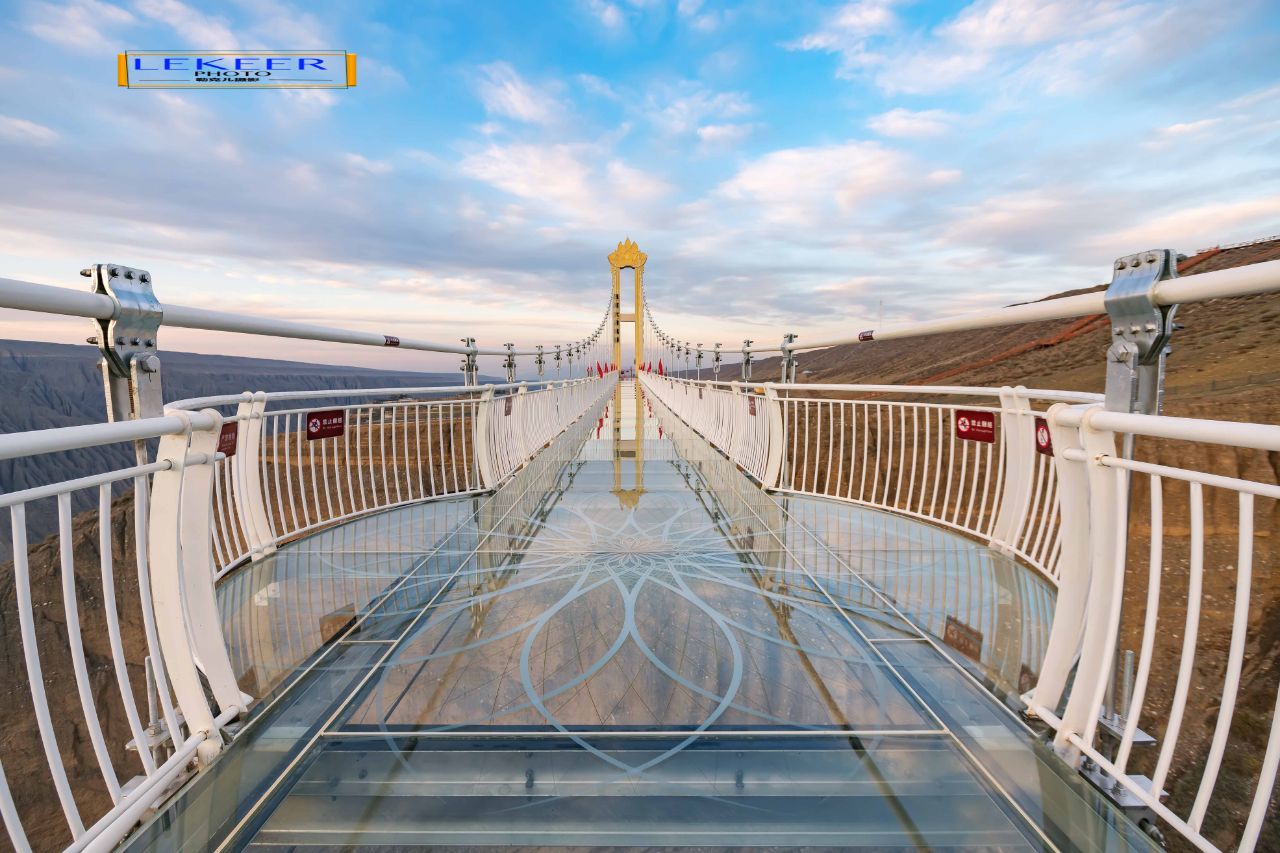
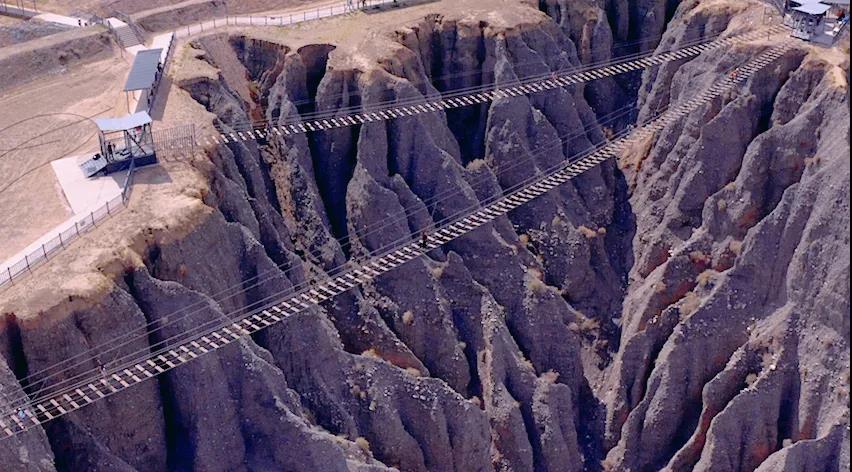
"Duku Glass Footbridge is located in a remote area of the arid Dushanzi Grand Canyon in Xinjiang, China. Although not as high as many other glass footbridges in China, the wide main span is quite large at 186 meters.There is also a zipline and some slat style footbridges near the glass bridge. "
Duku Glass Footbridge 独库大玻璃桥 is in the district of Dushanzi in Xinjiang, China, south of Kuytun. The glass bridge is 246 ft / 75 m high and has a 610 ft / 186 m span.
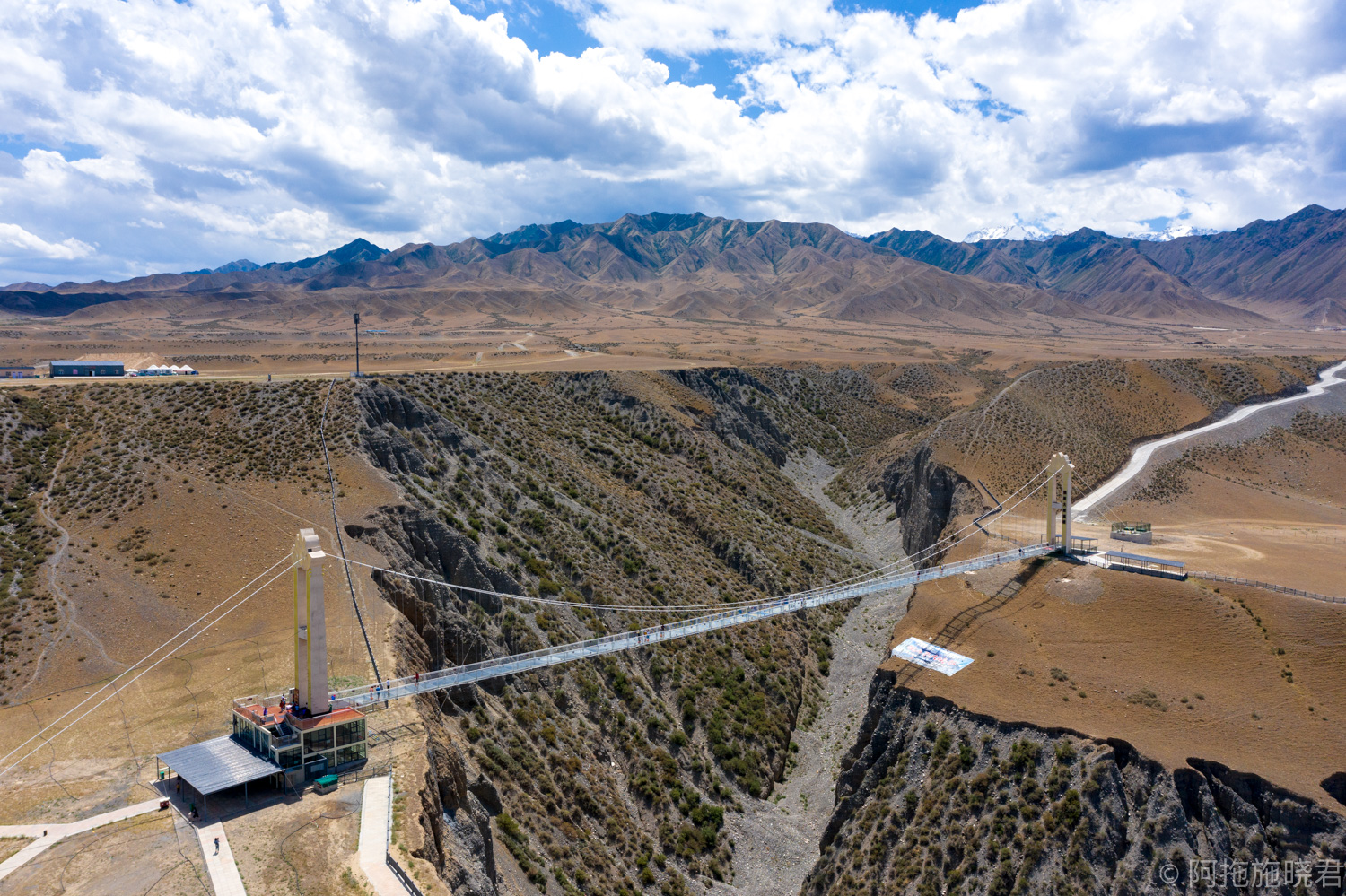
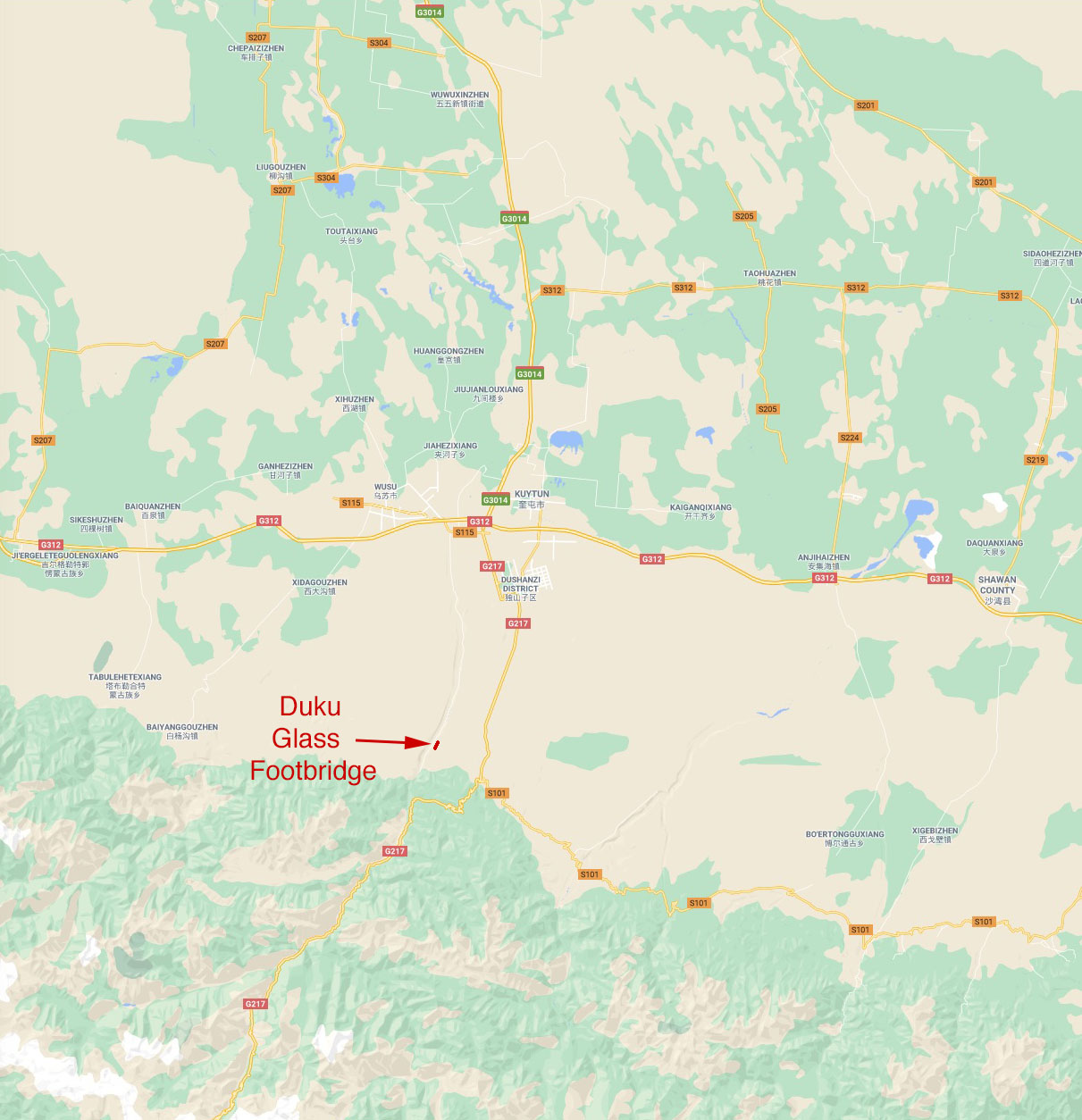 The Duku Glass Footbridge and the gap bridges are located off the G217 "Duku Highway" south of the town of Kuytun which is the train and road (G312/G217) junction of Dushanzi district.
The Duku Glass Footbridge and the gap bridges are located off the G217 "Duku Highway" south of the town of Kuytun which is the train and road (G312/G217) junction of Dushanzi district.
Kuytun/Dushanzi is linked by rail to Altay in the north-west, but much closer (still about 300km from Ürümqi along the train line to Kazahstan or along the G312 highway.). Kuytun can also be accessed by road (along the G217 highway which journeys from Burqin county in the north near Altay, all the way south to Kuqa on the edge of the Taklamakan desert) or by rail from Karamay, a booming city north of Kuytun, with a busy airport.
More about the Dushanzi Grand Canyon (the small Kuitan river runs north south, but the bottom of the canyon is rocky, reflecting light) in this 6 minute video:
https://www.youtube.com/watch?v=HffoyiHyl9w .
And the Duku highway (especially the G217 mountain stretch) is a spectacular road but "only opens for 3months. As one of the peculiar and hazardous roads, Dushanzi-Kuqa Highway, 561 kilometers in length, is a highway connecting Xinjiang's southern and northern areas. It stretches across steep mountains and passes through deep peaks and valleys, connecting numerous ethnic communities. " A 15 minute video here:
Recent Discussions
-
BL Drama Lovers Club2 minutes ago - axdxex
-
Error messages when submitting comments, messages etc.3 minutes ago - JulyMoon
-
[Discussion/Search] Find that Drama! (by desc. or plot)16 minutes ago - Kdragon107
-
What was the last (Non-Asian) show you completed?25 minutes ago - anyyy
-
!! Thoughts For the Day !!33 minutes ago - onigen
-
What was the last song (non Asian) that you listened to? #239 minutes ago - onigen
-
JOL Season 2: casting, filming & broadcast/air dates discussion39 minutes ago - darkstar
-
What are some of your favorite hobbies?1 hour ago - WalterChang
Hottest Discussions
-
10 dramas/movies with ____? #422 minutes ago
-
✰ Last letter food game ✰2 hours ago
-
Add and Subtract ( shuffle) new round19 minutes ago
-
Change 1 letter to make a new word #24 hours ago
-
Keep a word, drop a word #24 hours ago
-
The ALPHABET Game [drama /movie version]1 hour ago





